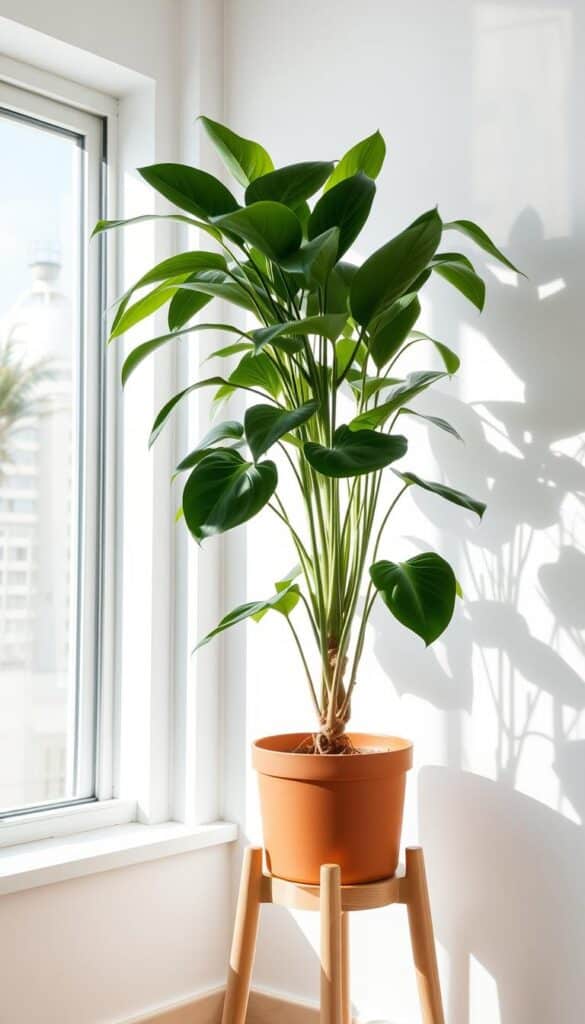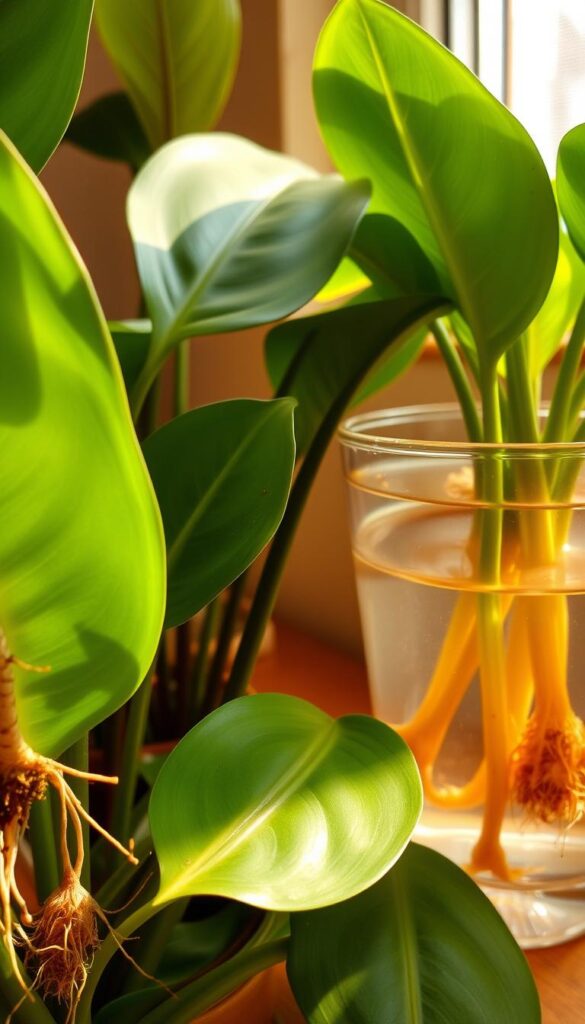Welcome to my Philodendron Narrow care guide! If you’re anything like me, you love bringing a touch of the jungle into your home. This stunning houseplant, also known as Philodendron Jungle Boogie, has captured the hearts of many with its unique, long narrow serrated leaves and vibrant green color.
Native to South America, the Philodendron Narrow is a popular choice for plant enthusiasts. Its adaptability and relatively easy maintenance make it perfect for both beginners and seasoned plant lovers. Plus, it’s a great way to add some natural beauty to your space.
Before we dive into the nitty-gritty of Philodendron Narrow care, here’s what you need to know: this plant thrives in bright, indirect light and well-draining soil. It’s also important to keep it out of reach of pets and small children due to its toxic properties.
In this guide, I’ll walk you through everything you need to know to keep your Philodendron Narrow happy and healthy. From optimal watering techniques to propagation tips, I’ve got you covered. Whether you’re a green thumb or just starting out, this guide is here to help you succeed.
Understanding Your Philodendron Narrow
Getting to know your Philodendron Narrow is the first step in becoming a great plant parent. This unique plant, also known as Philodendron Jungle Boogie or Philodendron Narrow Tiger Tooth, boasts long, narrow, and serrated leaves that give it a distinctive appearance. Native to South America, it’s a favorite among plant enthusiasts for its striking look and adaptability.
One of the standout features of the Philodendron Narrow is its leaf texture. The leaves are not only narrow but also have a serrated edge, which adds to their visual appeal. This texture is a key identifier for the plant, helping enthusiasts distinguish it from other philodendron varieties. Additionally, the plant’s natural shape is quite compact, making it a great choice for smaller spaces without compromising on style.
When it comes to monitoring your plant’s health, there are a few common symptoms to watch out for. Brown leaf edges can indicate underwatering, while yellowing leaves may signal overwatering. Droopy leaves are another sign that your plant might need more water. Pest infestations, such as mealybugs or spider mites, can also affect the health of your Philodendron Narrow. Regular inspections can help you catch these issues early and take appropriate action.
Understanding these characteristics and symptoms is crucial for providing the right care. By recognizing the signs of stress or pests, you can address problems before they become serious. This proactive approach ensures your Philodendron Narrow remains healthy and thrives in its environment.
Creating the Perfect Environment for Your Plant
Setting up the right environment is key to helping your Philodendron Narrow thrive. It’s all about finding that sweet spot where light, temperature, and humidity come together perfectly.
To start, light is essential. Place your plant near a window, but keep it out of direct sunlight. East- or west-facing windows are ideal because they offer bright, indirect light without the harsh rays that can burn the leaves. Aim to keep it within 6 feet of a window to ensure it gets enough light without overexposure.

Temperature and humidity also play a big role. Keep your plant in an area with a consistent temperature between 18°C and 24°C. As for humidity, aim for 40-70%. You can boost humidity by placing the pot on a tray with water and pebbles or using a humidifier.
Seasonal changes can affect your plant’s needs. During summer, ensure it’s shaded from intense sunlight. In winter, reduce watering and maintain a stable temperature. By adjusting your care routine, you can keep your Philodendron Narrow healthy year-round.
Getting the environment right is the foundation for a happy plant. With the right light, temperature, and humidity, your Philodendron Narrow will flourish, bringing joy and beauty to your space.
Mastering Watering, Soil, and Fertilization
Watering your Philodendron Narrow is an art that requires attention to detail. The goal is to keep the soil moist but never soggy, as this can lead to root rot. Here’s how I approach it:
Watering Techniques and Schedules
To ensure your plant stays healthy, water thoroughly once a week during summer. In winter, reduce this to every 10-14 days. Always check the soil dryness by sticking your finger into the soil up to the first knuckle. If the soil feels dry, it’s time to water.
Soil Selection and Drainage Tips
Choose a well-draining, organic potting mix that retains moisture but prevents waterlogging. Proper drainage is key to preventing root issues. If you notice water pooling in the pot, it might be time to repot your plant with fresh soil and ensure the pot has good drainage holes.
Fertilizer and Nutrient Management
Feed your Philodendron Narrow with a balanced organic fertilizer once a month. Dilute the fertilizer to half the recommended strength to avoid burning the roots. Repotting annually or when the plant doubles in size ensures fresh nutrients and supports healthy growth.
By mastering these care steps, you’ll enjoy consistent, vibrant growth from your Philodendron Narrow.
philodendron narrow care guide: Advanced Tips & Propagation
Taking your plant care to the next level involves mastering propagation and troubleshooting. These advanced techniques will help you expand your plant collection and keep your Philodendron Narrow thriving.
Propagation Through Stem Cuttings
Propagating your Philodendron Narrow is a rewarding process that can give you new plants to share or enjoy. Start by selecting a healthy stem with at least two nodes. Cut just below a node using clean scissors or pruning tools. Remove lower leaves to encourage root formation, leaving only a few at the top.
- Place the cutting in water, changing it every few days until roots develop (about 10cm).
- Transfer to a well-draining pot with quality potting mix. Keep the soil moist but not soggy until established.

Troubleshooting Issues Like Yellow and Droopy Leaves
Yellow leaves often indicate overwatering, while droopy leaves might mean it’s time to water. Check the soil moisture by sticking your finger in up to the first knuckle. If dry, water thoroughly.
- Overwatering: Allow soil to dry slightly between waterings.
- Underwatering: Increase watering frequency, ensuring the pot drains well.
- Pests: Inspect leaves for mealybugs or spider mites. Treat with insecticidal soap if necessary.
By addressing these issues promptly, you can help your plant recover and maintain its health.
Wrapping Up Your Plant Journey
Welcome to the final chapter of your Philodendron Narrow journey! With the tips and insights shared in this guide, you’re well-equipped to create a thriving environment for your plant. Remember, it’s all about balance—proper watering, ample light, and the right nutrition will keep your Philodendron Narrow happy and healthy.
By following the simple yet detailed steps outlined in this guide, you can confidently master the art of plant care. Whether you’re nurturing your Philodendron Narrow on a sunny windowsill or propagating new plants to share with friends, the key is consistency and attention to detail.
Always keep in mind the safety of your pets, as this plant can be toxic to them. Monitoring your plant’s health regularly is essential, much like caring for a small tree in your home. With a little patience and care, your Philodendron Narrow will flourish, bringing joy and beauty to your space.
Use this guide as a trusted resource to troubleshoot common issues and refine your plant care routine. Embrace the journey of nurturing your Philodendron Narrow with dedication and a willingness to learn. Happy planting!
